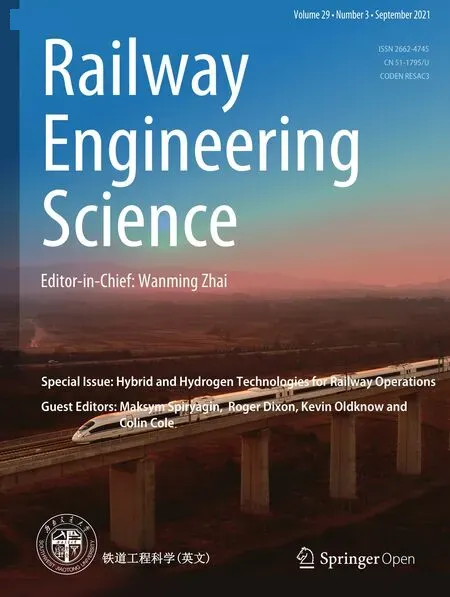Preface to special issue on hybrid and hydrogen technologies for railway operations
2021-12-05MaksymSpiryaginRogerDixonKevinOldknowColinCole
Maksym Spiryagin • Roger Dixon • Kevin Oldknow • Colin Cole
These are exciting times for those working to develop and introduce zero emission technologies for the manufacture and operation of clean transport systems. The automotive industry in particular is taking rapid and significant steps to develop and implement clean and sustainable transport technologies. The railway industry is, relatively speaking,conservative in its progress in this field because it requires expensive long-term financial investment in rolling stock and railway infrastructure. However, the rail industry is also beginning to increase the pace of development. With the transition to clean technologies in rail broadly expected to be implemented in 2030–2050, much of the research now in progress is focused on the appraisal of batteryelectric, hydrogen, and hybrid technologies. This includes modelling, simulation, design, and the development of prototypes for testing on existing railway routes.
In this special issue, research teams from Australia,Canada, China, Italy, USA, and the UK contribute their reviews, design ideas and concepts in this field. They also outline the progress of several recent and current numerical, experimental, and field works on the development of hybrid and hydrogen solutions applicable to railway applications.
The editors of this special issue believe that the manuscripts published will provide thought provoking and interesting reading, covering their analysis of the development of new ideas in the field of hybrid and hydrogen technologies for rail; we also anticipate that it will stimulate further research in the area,with huge opportunities to make further improvements in alternative power technologies, rolling stock design, and railway infrastructure.
Open AccessThis article is licensed under a Creative Commons Attribution 4.0 International License, which permits use, sharing,adaptation,distribution and reproduction in any medium or format,as long as you give appropriate credit to the original author(s) and the source,provide a link to the Creative Commons licence,and indicate if changes were made.The images or other third party material in this article are included in the article’s Creative Commons licence,unless indicated otherwise in a credit line to the material. If material is not included in the article’s Creative Commons licence and your intended use is not permitted by statutory regulation or exceeds the permitted use, you will need to obtain permission directly from the copyright holder. To view a copy of this licence, visit http://creativecommons.org/licenses/by/4.0/.
杂志排行
Railway Engineering Science的其它文章
- A review of hydrogen technologies and engineering solutions for railway vehicle design and operations
- Energy management strategy based on dynamic programming with durability extension for fuel cell hybrid tramway
- An investigation into intermittent electrification strategies and an analysis of resulting CO2 emissions using a high-fidelity train model
- Analysis of positioning of wayside charging stations for hybrid locomotive consists in heavy haul train operations
- Feasibility study of a diesel-powered hybrid DMU
- Feasibility of hydrogen fuel cell technology for railway intercity services: a case study for the Piedmont in North Carolina
